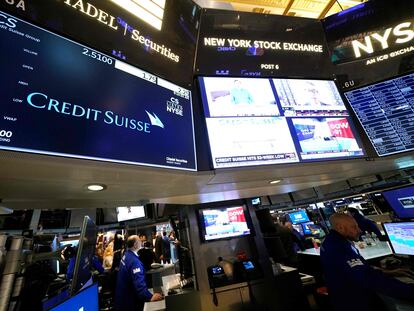Markets wait for ECB chief Lagarde to appease financial panic in the euro zone
Following the Credit Suisse crisis, analysts are divided on whether the central bank will follow through on plans to raise rates by 0.5 points or reduce it to 0.25

Everything was ready. The president of the European Central Bank (ECB), Christine Lagarde, had already said in early February that she would raise interest rates by half a point to 3.5%. There was nothing to suggest that the institution would have any reason to double-guess itself. But the financial instability unleashed by the Silicon Valley Bank and Credit Suisse crises has broken into the Governing Council of Europe’s monetary authority, gathered since Wednesday in Frankfurt.
The consensus among economists is broken: while some believe that the ECB will not back down to avoid spreading the impression that things are getting serious, others think it is inevitable that policymakers will raise the price of money by no more than a quarter of a point. In any case, Lagarde will have to carefully ponder every word she utters to convince the markets that the situation is under control.
European central bankers already have the new economic forecasts for the euro area to 2025. This document was meant to help them outline the ECB’s roadmap for the coming months, although some members were asking for more robust action. The Austrian governor had even suggested bringing interest rates to 5% between now and the summer.
Until the end of last week, tailwinds were blowing for the more orthodox sector of the Council: the economy continues to resist recession, labor markets remain strong and inflation is soaring, especially in food items. In other words, everything indicated that there would be a half-a-point rate hike. But the collapse of a medium-sized bank on the US West Coast changed everything by putting the Old Continent on guard. The subsequent crisis of Credit Suisse, which has asked the Swiss central bank for help, sent markets tumbling on Wednesday.
The ECB made a move by asking all eurozone banks to assess their exposure to Credit Suisse, according to The Wall Street Journal. The markets, however, expect more. And they expect it today. They are awaiting a message from Lagarde that will act as a firewall for the banks of the 20 single-currency economies, which this week have accumulated substantial losses. “It is very hard for me to see the ECB going back on its decision, because that might even be viewed as a sign that the situation is worse than we imagined. It will be interesting to see the tone and content of the Council’s statement and the subsequent news conference,” said Antoni Garrido, a professor of economics at the University of Barcelona. Garrido recalls that, after price stability, the ECB has implicitly assumed the mission of ensuring the financial stability of the euro zone, and that is the direction in which he believes the message from the monetary authority will go.
‘Too big to ignore’
Until Wednesday, all analysts were in agreement. No longer. Bloomberg economists, for example, believe the Eurobank will give up on its half-a-point target and raise rates by just a quarter of a point. Their argument is that it is unclear if Credit Suisse is too big to fail, but it is certainly too big to ignore. The investment bank Nomura, on the other hand, continues to bet on a rise of half a point, although it is not entirely ruling out the other option “as a result of the uncertainty” generated by the banking crises. Former ECB Vice-President Vítor Constâncio stated through his Twitter account: “Central Banks should not ignore the signs from the markets and the more likely recession forthcoming. They should tone down their hiking campaign. The ECB should do at most 25 bps and not the announced 50 pbs.”
All options are open. If the rate hike is finally 0.25, Lagarde will be forced to take a more aggressive tone against inflation. And vice versa: if the ECB opts for 0.5, it should leave the door wide open to easing its plan for the coming months. That will depend on the balance within the Governing Council, where the doves have barely gotten a few nods in recent months. “The multiplicity of financial risks requires some flexibility in carrying out monetary tightening,” says Axel Botte, global market strategist at Ostrum AM. The turmoil in the financial markets could also force the ECB to put its bond reduction strategy on hold to avoid any slip-ups in the sovereign debt markets.
Sign up for our weekly newsletter to get more English-language news coverage from EL PAÍS USA Edition
Tu suscripción se está usando en otro dispositivo
¿Quieres añadir otro usuario a tu suscripción?
Si continúas leyendo en este dispositivo, no se podrá leer en el otro.
FlechaTu suscripción se está usando en otro dispositivo y solo puedes acceder a EL PAÍS desde un dispositivo a la vez.
Si quieres compartir tu cuenta, cambia tu suscripción a la modalidad Premium, así podrás añadir otro usuario. Cada uno accederá con su propia cuenta de email, lo que os permitirá personalizar vuestra experiencia en EL PAÍS.
¿Tienes una suscripción de empresa? Accede aquí para contratar más cuentas.
En el caso de no saber quién está usando tu cuenta, te recomendamos cambiar tu contraseña aquí.
Si decides continuar compartiendo tu cuenta, este mensaje se mostrará en tu dispositivo y en el de la otra persona que está usando tu cuenta de forma indefinida, afectando a tu experiencia de lectura. Puedes consultar aquí los términos y condiciones de la suscripción digital.
More information
Archived In
Últimas noticias
Most viewed
- Sinaloa Cartel war is taking its toll on Los Chapitos
- Oona Chaplin: ‘I told James Cameron that I was living in a treehouse and starting a permaculture project with a friend’
- Reinhard Genzel, Nobel laureate in physics: ‘One-minute videos will never give you the truth’
- Why the price of coffee has skyrocketed: from Brazilian plantations to specialty coffee houses
- Silver prices are going crazy: This is what’s fueling the rally










































